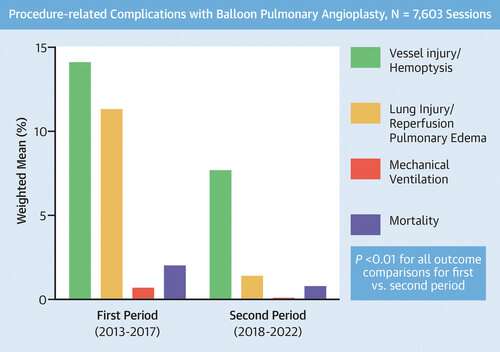This article has been reviewed according to Science X's editorial process and policies. Editors have highlighted the following attributes while ensuring the content's credibility:
fact-checked
trusted source
proofread
Complications for procedure to open clogged pulmonary arteries have decreased significantly, finds study

For patients with high blood pressure in their pulmonary arteries caused by chronic blood clots, complications after a minimally invasive balloon angioplasty have decreased substantially over the last decade, a Michigan Medicine-led study finds.
Researchers examined over 7,500 cases of balloon pulmonary angioplasty for patients with chronic thromboembolic pulmonary hypertension, an elevated blood pressure in the pulmonary arteries due to persistent blockages known as CTEPH, between 2013 and 2022. The procedure, which is offered for patients who are not candidates for surgery, involves inflating a balloon inside of diseased lung arteries to break up clots and restore blood flow to the lungs.
Results published in JACC: Cardiovascular Interventions reveal that the once feared severe complications that occur during balloon pulmonary angioplasty—lung injury, coughing up blood and death—all dropped in the latter half of the study decade.
From 2013 to 2017, 11.3% of CTEPH patients experienced lung injury after balloon pulmonary angioplasty, compared to 1.4% between 2018 and 2022. During those same time periods, instances of patients coughing up blood dropped from 14.1% to 7.7% and mortality decreased from 2% to 0.8%.
"Over the last decade, it is clear that balloon pulmonary angioplasty has become a more established, safer option for inoperable CTEPH," said senior author Vikas Aggarwal, MBBS, interventional cardiologist at the University of Michigan Health Frankel Cardiovascular Center. "We believe these decreased complication rates are largely due to refinement in technique, as well as patient selection. We are learning how to do this procedure in a safer manner with increasing experience over time."
The minimally invasive procedure is performed at select centers worldwide, most often done in an inpatient setting with patients monitored for one to three days after. Another Michigan Medicine-led study in 2023 found that balloon pulmonary angioplasty can be safely performed in an outpatient setting utilizing a novel care delivery protocol.
Outside of balloon pulmonary angioplasty, there are few nonsurgical treatments for CTEPH, which can develop in nearly 5% of all patients with acute pulmonary embolism. Some patients will be treated with lifelong anticoagulation and riociguat, the only approved medication to dilate blood vessels in patients with CTEPH.
"As it becomes clearer that balloon pulmonary angioplasty is a safe and effective treatment that can be carried out in both the inpatient and outpatient setting, there is potential for more centers across the country to start CTEPH programs," said Victor Moles, M.D., co-author and clinical assistant professor of internal medicine-cardiology at U-M Medical School.
Michigan Medicine is contributing to expanding the knowledge and experience of the procedure by offering complimentary, live on-site programs where interested institutions can learn how to successfully implement balloon pulmonary angioplasty.
"These programs have the potential to greatly increase access and quality of care in treatment of CTEPH," said Aggarwal, who is also a clinical assistant professor of internal medicine-cardiology at U-M Medical School.
More information: Nishant Jain et al, Periprocedural Complications With Balloon Pulmonary Angioplasty, JACC: Cardiovascular Interventions (2023). DOI: 10.1016/j.jcin.2023.01.361



















